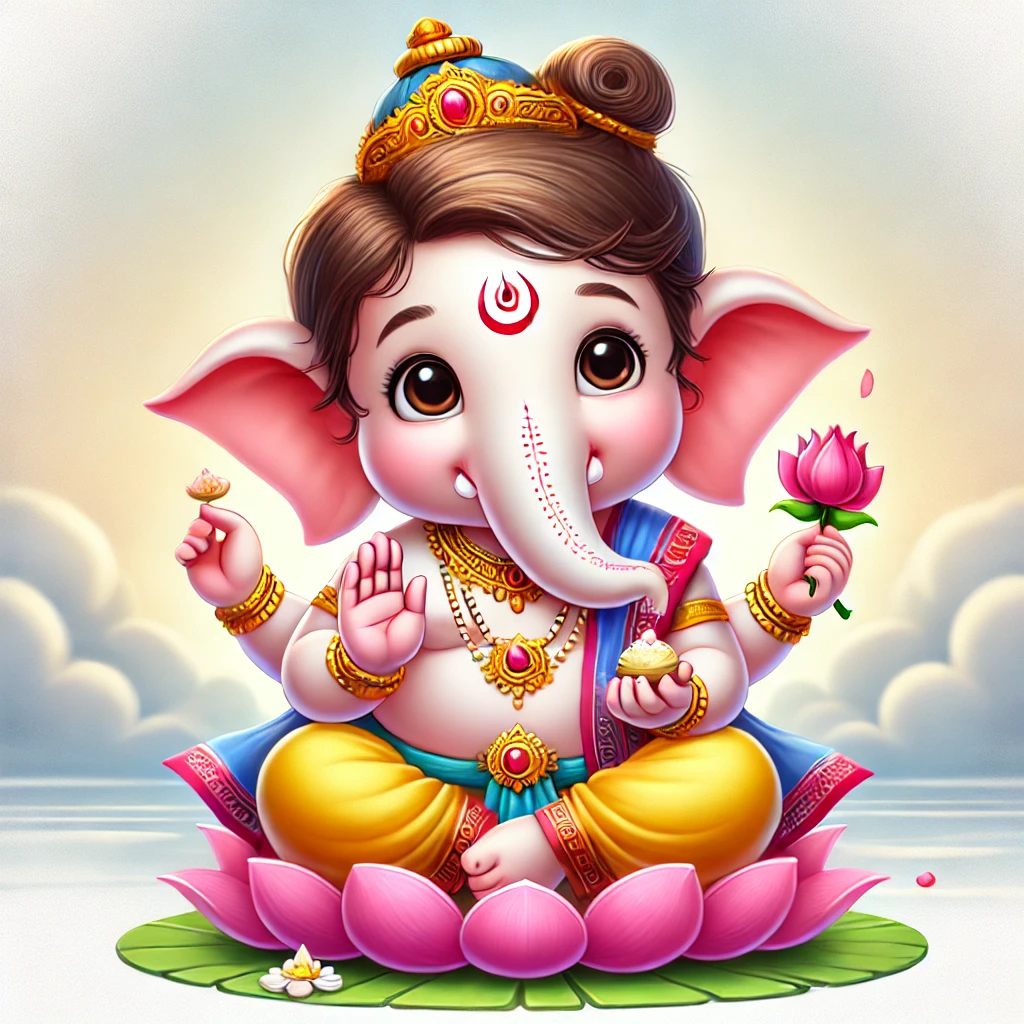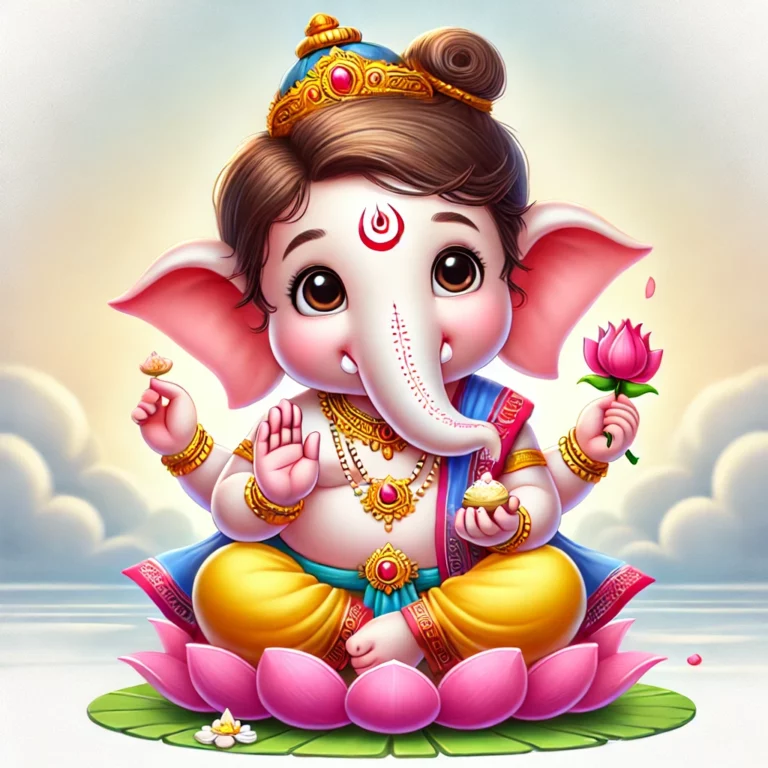🌼 Ganesh Chaturthi 🌼

॥ ॐ श्री परमात्मने नमः ॥
🚩 Ganesh Chaturthi 2024🚩

Ganesh Chaturthi 2024: Origin
Ganesh Chaturthi’s origins can be traced back to the 17th-century Maratha Empire, when Chhatrapati Shivaji Maharaj observed the holiday to encourage patriotism and solidarity among his subjects.
But during the British colonial era, the festival became well known as freedom fighter Lokmanya Tilak utilized it as a platform to unite people and motivate them to fight for independence. Ganesh Chaturthi, also known as Vinayaka Chaturthi or Ganesh Utsav, is a significant Hindu holiday that honors Lord Ganesha’s birthday and has great spiritual significance.
Hindu mythology holds that Goddess Parvati created him, breathing life into him from her own body. Known as “Vighnaharta,” or the one who removes obstacles, Lord Ganesha is revered as the deity of knowledge, intellect, and learning. Devotees seek his blessings for success in their endeavours, education, and new beginnings.
***
🕰️Ganesh Chaturthi 2024 Date & Time:📅
📅 Ganesha Chaturthi: Saturday, September 7, 2024 🕰️
📅 Madhyahna Ganesha Puja Muhurat : 11:37 AM to 02:06 PM 🕰️
📅 Duration: 02 Hours 29 Mins 🕰️
📅 Ganesha Visarjan : Tuesday, September 17, 2024 🕰️
📅 On previous day time to avoid Moon sighting: 03:01 PM to 08:56 PM, Sep 06 🕰️
📅 Duration: 05 Hours 55 Mins 🕰️
📅 Time to avoid Moon sighting: 09:56 AM to 09:27 PM 🕰️
📅 Duration :11 Hours 31 Mins 🕰️
📅 Chaturthi Tithi Begins – 03:01 PM on Sep 06, 2024 🕰️
📅 Chaturthi Tithi Ends – 05:37 PM on Sep 07, 2024 🕰️
***
🔰 What Rituals are Observed for Vinayaka Chaturthi?
Though the festival is the same and has similar connotations across India, each region has slight variations in rituals and traditions. The celebrations last between 7 and 10 days at different places. A few common observances are:
Installation of Ganapati statue: A statue of the Elephant God is installed on a pedestal either at home or in a public place with a pranprathishtha puja.
Not looking at the moon: On the first night of the festival, people avoid looking at the moon because it is considered a bad omen.
Prayers: Washing of the statue; puja with the chanting of shlokas and offerings of flowers and sweets; and aarti, i.e. circumlocution of the idol with a plate filled with a lit earthern/metal lamp, kumkum and flowers, is done. Prayer meetings are also conducted at Ganapati temples and public installations every day in the evenings and in some places, in the mornings as well.
Special performances: Some public installations of Lord Ganesh might also have performances with dance, music, and skits.
Making and eating modak: Modak is believed to be Ganapati’s favourite sweet. So, these dumplings are made and distributed as prasad during the festival. Other food items such as laddoo, barfi, pedha, and sundal are also distributed during this time.
Visarjan: This is the immersion of the idol in a water body and is conducted on the last day – anywhere between the seventh and eleventh days – of the festival. It is accompanied by a procession of people chanting bhajans and shlokas and songs, with the idol. People seek forgiveness for the mistakes they have done so far and request the god to help them stay on the righteous path. Ganesha is thanked for visiting the home/locality, for being removing obstacles from people’s path, and for the auspiciousness he bestows.
***
🔰Farewell Procession🔰
The festival’s spectacular finale is the farewell parade, or Ganesh Visarjan. During this festival, the god’s placed idols are submerged in a body of water. You could choose to submerge yourself in the closest lake, river, sea, or pond. If there isn’t a big body of water nearby, people can still perform symbolic immersions by submerging the idol in a tiny container or barrel of water at home.
The idol is transported in a massive procession, led by devotees singing bhajans or songs, from the installation site—a house or a public pandal—to the body of water. Depending on the idol’s size, it can be transported in a car, on a wooden carriage, or on the shoulders of the family’s head or a representative of the community.
Chants of Ganapati Bapa Moriya, bhajans, dance, and the giving out of prasad and flowers accompany all of these events.
***
🔰Why are Ganesha Statues Immersed in Water on the Last Day of the Festival?
The festival’s conclusion and the idea that everything on Earth finally combines with one or more of the elements of nature are symbolized by Ganesh Visarjan. It also represents Lord Vinayak’s birth cycle, since he was formed of clay at birth and returns to the elements in that manner. In other words, after spending seven to ten days among his followers, he is literally returning to his heavenly residence.
***
🔰What is the Significance of Ganesh Chaturthi?
People gather to worship Lord Ganesha, who is revered as the son of Lord Shiva and Goddess Parvati, on Ganesh Chaturthi, and he occupies a particular place in their hearts. This festival has its origins in an intriguing legend. When Ganesha was a child, he was given the responsibility of watching over his mother’s bath and was told to keep everyone out. Lord Shiva tried to enter as well, but Ganesha dutifully stopped him. Lord Shiva unintentionally chopped Ganesha’s head out of frustration. Goddess Parvati was so moved by this event that she insisted on the resurrection of Ganesha.
In order to bring Ganesha back to life, Lord Brahma attached an elephant’s head to his body, which is why he is so often portrayed as an elephant-headed god. Lord Ganesha’s unusual visage has come to be associated with him. In addition to his unusual appearance, he is well known for his ability to clear people’s paths, provide success and wealth.
People celebrate the rebirth of Lord Ganesha by remembering and celebrating Ganesh Chaturthi. It gives people a chance to show their steadfast commitment to him and ask for his blessings, enabling them to overcome whatever obstacles they may come across along the way.
***
🔰 How is Ganesh Chaturthi Celebrated?
Ganesh Chaturthi unfolds as a vibrant 10-day jubilation, characterized by the adornment of Ganpati idols, earnest prayers within homes and public shrines, melodious Ganesh Chaturthi aarti, and an array of cultural commemorations.
***
🔰 A Glimpse of the 10-Day Celebration:
Day 1: Embracing Lord Ganesha with Devotion and Clay Creations: The commencement of Ganesh Chaturthi witnesses the installation of Lord Ganesha’s divine idol, gracing both homes and transient pandals. Devotees offer fervent prayers, while the market bustles with an assortment of clay idols, each chosen with care to match its intended abode.
Day 2: The Centrality of the Festival: The second day, aptly termed ‘Chaturthi’ assumes a pivotal role as the heart of the entire celebration.
Day 3: An Exclusive Tapestry of Prayers and Aarti for Lord Ganesha: On the third day, devotees devote themselves to distinct prayers and engage in the ritualistic aarti, channeling their reverence towards Lord Ganesha.
Day 4: Revelry with Devotions, Aarti, and Delectable Offerings: The fourth day resonates with joyous prayers, accompanied by aarti ceremonies and the presentation of delectable sweets as tokens of devotion to Lord Ganesha.
Day 5: Immersion in the Shhodashopachara Pooja for Lord Ganesha: The fifth day encapsulates the ‘Shhodashopachara Pooja’ an intricate ceremony encompassing 16 facets of worship, serving as a homage to Lord Ganesha.
Day 6: Homebound Prayers: Aartis usher in joy as the sixth day dawns, known as ‘Sashti’ intimate prayers and soul-stirring aartis fill the homes of devotees.
Day 7: A Sacred Voyage: Through Special Prayers and Saptapadi or day seven, distinguished as a day of ‘Saptapadi’ entails the performance of the sacred seven steps, accompanied by fervent supplications to Lord Ganesha.
Day 8: The Reverent Ashtami: Celebrated as ‘Ashtami’ the eighth day unfolds with dedicated prayers, aarti rituals, and the presentation of delightful confections offered to Lord Ganesha.
Day 9: An Affectionate Tribute to Nine Plants: The penultimate day embraces the ‘Navapatrika Pooja’ a heartfelt tribute paid through the worship of nine distinct plants.
Day 10: A Majestic Procession and Ganesh Visarjan: The grand finale, known as ‘Vijayadashami,’ signifies the culmination of the festival. Lord Ganesha’s resplendent idol embarks on a grand procession, culminating in its immersion, known as Ganesh Visarjan, into the nearby waters.
Over these ten days, communities immerse themselves in the festivities, joining public revelries and visiting the homes of kin and friends. Cultural galas come to life with harmonious melodies and rhythmic dances. Devotees, in their spirit of compassion, extend their support to the less fortunate through charitable acts, including the donation of clothing and sustenance.
***
🔰 Gajanan Sankashti Chaturthi Puja Vidhi:
- On the day of the fast, get up early in the morning and retire from daily activities.
- After this, take a bath and wear clean clothes.
- Then take a pledge of fasting and Ganesh Puja by taking water in your hand.
- After that, install the idol of Ganesh ji on a stand in the auspicious muhurta.
- Offer clothes, yellow and red flowers, Akshat, turmeric, durva, sandalwood, vermillion, betel leaf, betel nut, mauli, sacred thread, incense, lamp, fragrance, naivedya etc. to Ganesh ji.
- During this, we keep chanting the mantra Om Gan Ganpataye Namah.
- After this, offer laddus, modaks, fruits etc. to Ganesh ji.
- Then recite Ganesh Chalisa and recite the story of Chaturthi fast and finally do the aarti of Ganpati ji.
***